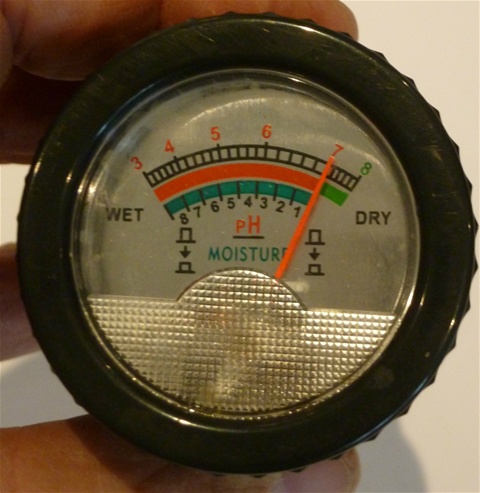pH measurement of compost

“Compost just happens” and it is not necessary for the gardener or recycler to know how or why. Action on the composter’s part to control the pH during composting is not normally necessary provided the process remains aerobic; you can just add the Greens and Browns (See
Compost C: N Ratio) to the bin and leave them until they are turned into compost. However a greater understanding of the process can add to the enjoyment of composting and regularly and checking the pH during can enable the composter to monitor the process of decomposition. The pH levels in a compost bin will vary throughout the aerobic composition process as the microorganisms act on the material, it will also vary in different parts of the bin unless the material is regularly mixed. If anaerobic decomposition occurs and the contents start to turn black, wet and smelly, it will become more acidic due to the production of organic acids.
pH is the measure of the acidity or alkalinity or hydrogen ion activity of a soil or compost (on a logarithmic scale). from 0 to 14 with a pH or 7 being considered “neutral”. A pH change of one unit on the scale means a 10-fold increase or decrease of acidity. A pH of less than seven means that the substance is acidic while a value of above seven that it is alkaline.
pH changes in compost
Most finished composts are about neutral pH within a range from 6 – 8. However, the initial pH of home compost, being made with the usual mix of vegetable trimmings, food waste and other household compostable material, is likely to be more acidic perhaps between 5.0 and 7.0. If a significant proportion of the material being composted is wood shavings or peat moss, perhaps from chicken bedding, the pH may be as low as pH 4.5.
If the compost has been collected and stored to be added with other waste in a hot composting system and has started decomposing anaerobically e.g. in a heap of grass clippings, the anaerobic organisms will have produced acids lowering in the pH.
The initial pH of composts will be more alkaline, with a pH as high as 8.5, where the material contains a significant proportion of manure or wood ash.
Compost microorganisms grow and multiply within the pH range of 5.5 to 8. Organic acids are formed in the initial stages of the aerobic decomposition process and these acidic conditions favour the growth of fungi and the breakdown of lignin and cellulose. This means that if the initial pH of the material was six or seven it may fall due to the formation of these acids during the initial stage of the decomposition.
Where the initial pH is 5.0 or 5.5 the pH remains relatively constant during this period.
It is during these initial slightly acid conditions that the activity of composting microorganism causes the compost temperature to increase rapidly during the first few days and with it, the pH begins to rise, as the organic acids become neutralized giving mature compost generally a pH of between 6 and 8.
In addition to the initial microbial activity, compost can also become acidic when there is insufficient oxygen and the microbe activity becomes anaerobic. This may be due to having too many nitrogen rich greens in the bin e.g. grass cuttings, or lack of aeration.
Traditionally lime was incorporated into the compost heap and while lime will act as a buffer, keeping the pH from becoming too acidic or too alkaline. Adding lime is not necessary provided aerobic decomposition is maintained and even then, it is no longer favoured by many composters. Indeed, there is a view that the addition of lime may have an adverse effect because it causes nitrogen to be lost to the atmosphere as ammonia gas reducing the nitrogen content of the compost. Aerating or remixing the anaerobic material while including more “Browns” should return an anaerobic mixture to aerobic decomposition
The compost pH will become neutral or alkaline as it matures pH values of less than six and above eight may indicate a problem with the composting process or the source materials. If you use a maturation bin and have been monitoring the pH during the composting process continue to take readings until completion of the maturation process.


 Get them and their friends super lit LOL
Get them and their friends super lit LOL